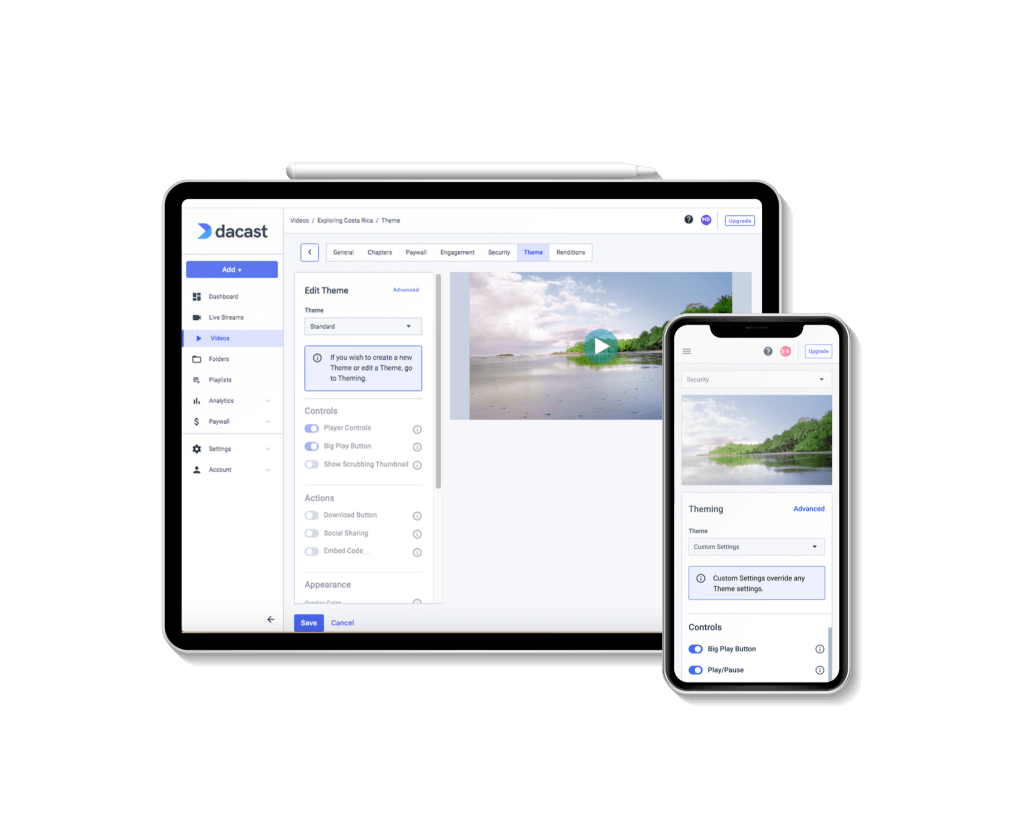Video Hosting For Mobile Apps: How to Build an App Using Streaming SDKs
Thanks to SDK technology, anyone can build an app that delivers live video streams. Furthermore, this technology enables users to live stream securely to Roku, mobile apps and any other device. The Dacast platform offers a video streaming SDK to its users and delivers live streams using HLS, the dominant streaming video protocol. The HLS streaming protocol has great benefits, including wide device and browser compatibility. Combined with M3U8 links, Dacast users can stream seamlessly to mobile devices. Mobile live streaming has never been easier or better.
The best part is you don’t need to write code expertly or need richly detailed documentation to make an SDK work. At Dacast, for example, simple and seamless documentation instruction and specialist support can help you build an app with all the features and functionality you need.
In this article, we’ll touch on the benefits of building and hosting a mobile streaming app. We’ll then break down live streaming mobile SDK and M3U8 links. After, we’ll cover M3U8 in the context of Dacast before discussing why mobile SDKs are the preferred alternative.
Table of Contents
- Why Build a Mobile Video Streaming App?
- What is Mobile SDK for Live Streaming?
- What to Know About Dacast M3U8 Link Files
- Why Use SDKs for Streaming to Mobile Apps and Set-Top Boxes?
- Building Mobile Apps Using Dacast’s iOS and Android SDKs
- Conclusion
Why Build a Video Streaming App?


Approximately 64% of enterprise video viewers access live streams from a mobile device and the average person spends 16 minutes watching videos on their smartphone each day. Additionally, CTV is on the rise, which means that people are accessing OTT videos from their smart TVs.
Although smartphone users can pull up videos on their browser, a dedicated app makes it easier for them to access a video player. A dedicated app also comes in handy for streaming on a smart TV since many of the smart TV operating systems and gaming consoles do not have browser access.
Improving the user experience will help you build a loyal brand following and keep viewers coming back. Building a video streaming app can help better accommodate your viewers.
What is Mobile SDK for Live Streaming?
In the context of live streaming, SDK stands for “software development kit.” The purpose of a video streaming SDK is to provide the tools required to build an app or program based on another software.
Dacast, for example, offers mobile SDKs for both iOS iPhones and iPads as well as Android devices that are meant to help users build apps around our HTML5 video player. This technology can be used to build apps for Apple, Android, Roku, Amazon Fire Stick, and more.
SDK is often discussed alongside API, which is a similar technology that allows you to integrate two pieces of software. API is not entirely relevant in the situation of app development, but it is important to know the difference between the two.
What to Know About Dacast M3U8 Link Files


A few different components comprise the default live stream configuration at Dacast. The video stream uses HLS delivery with HTML5 technology for playback. These channels also contain M3U8 links. These links contain M3U8 files that let the video player know the location of the video content for playback, along with a security token.
We’ve written about these security tokens in the past. Via a regular check-in system with Dacast servers, these tokens are responsible for enforcing security policies you may set such as password protection and restrictions.
We call these HTML5 Live Channels in the Dacast management back office. These are set up to use the default configurations for a Dacast live stream.
Dacast has another type of live channel called M3U8 Live Channels. These are designed for compatibility with Roku and other set-top boxes and the development of live streaming mobile apps.
Unfortunately, these channels don’t support Dacast’s security features, including password protection, referrer restrictions, geographic/IP restrictions, and so on. Since security is a major priority for many professional broadcasters, it is important to have the capability of testing your M3U8 links before you go live.
As the use of internet-connected Smart TVs is rising rapidly, this is a problem we have been working to solve. That is where SDKs come into play.
Why Use SDKs for Streaming to Mobile Apps and Set-Top Boxes?
Dacast is currently developing new SDKs aimed at Roku and other platforms. As opposed to M3U8 links, mobile streaming SDKs make it much easier for you to build and launch mobile and smart TV apps based on your mobile live broadcasts and on-demand video content.
These SDKs will include security tokens in all your live streams. This will allow you to securely live stream on Roku, Chromecast, Apple TV, and more.
Using an SDK also allows you to capture full analytics data. On the contrary, an M3U8 only allows the capture of very basic analytics. By using video streaming SDKs you can get a better idea of who is tuning into your streams which makes it easier for you to tweak your content to meet their needs going forward.
Building Apps Using Dacast’s iOS and Android SDKs


At Dacast, we already offer iOS and Android SDKs to our users. These live video streaming SDKs integrate with the Dacast API. They make it much easier to develop mobile apps of your own.
Building a video app using an SDK is fairly straightforward. However, the exact process will depend on the layout and complexity of your specific app, including the need for push notifications and other mobile features. Dacast also provides complete SDK documentation to help through the process.
Even with access to live streaming mobile SDK, you will still need some technical knowledge to bring your app to life. If you don’t have in-house specialists, you can hire Dacast’s professional services team to help you build apps today. Our trained experts regularly assist businesses and organizations in developing cutting-edge mobile apps, the right mobile live-streaming equipment, and many other aspects of live broadcasting.
Apple’s App Store and the Google Play Store both take a week or two to approve new apps. Added to development time, we recommend reserving at least a month to create and launch your new video app using Dacast’s SDKs.
Conclusion
Online video and video players are becoming increasingly popular. Over 33 million U.S. households have already cut the cord on their cable subscriptions in favour of online video, and this is only expected to rise. As a broadcaster, this means you can reach more viewers and customers all over the world. With SDK, you can create an app for live video streaming.
At Dacast, we provide easy-to-use SDKs for fast and seamless app building. Aimed at Roku and other platforms such as Apple TV and Chromecast, our secure solution will help you securely launch and build mobile and smart TV apps.
Want to start building and streaming and interested in learning more? View our live streaming pricing plans and features. Best of all, you can try Dacast today with our 14-day free trial and test drive our streaming platform.
Start today for free
For regular tips on live streaming and exclusive offers, you can also join the Dacast LinkedIn group.
Please note that this post was originally written by Max Wilbert. It was revised in 2021 by Emily Krings to include the most up-to-date information. Emily is a strategic content writer and storyteller. She specializes in helping businesses create blog content that connects with their audience.


